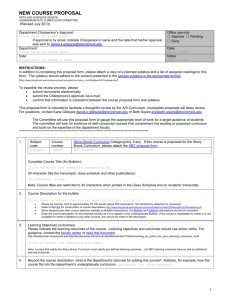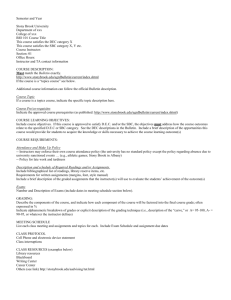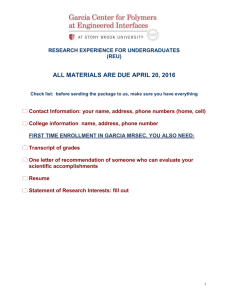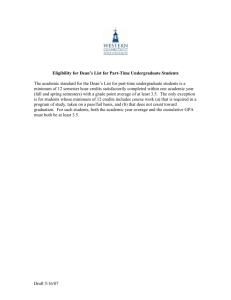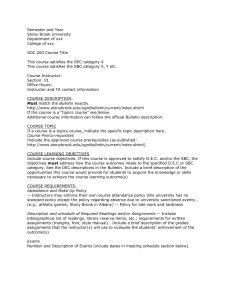COLLEGE OF ARTS AND SCIENCES
advertisement
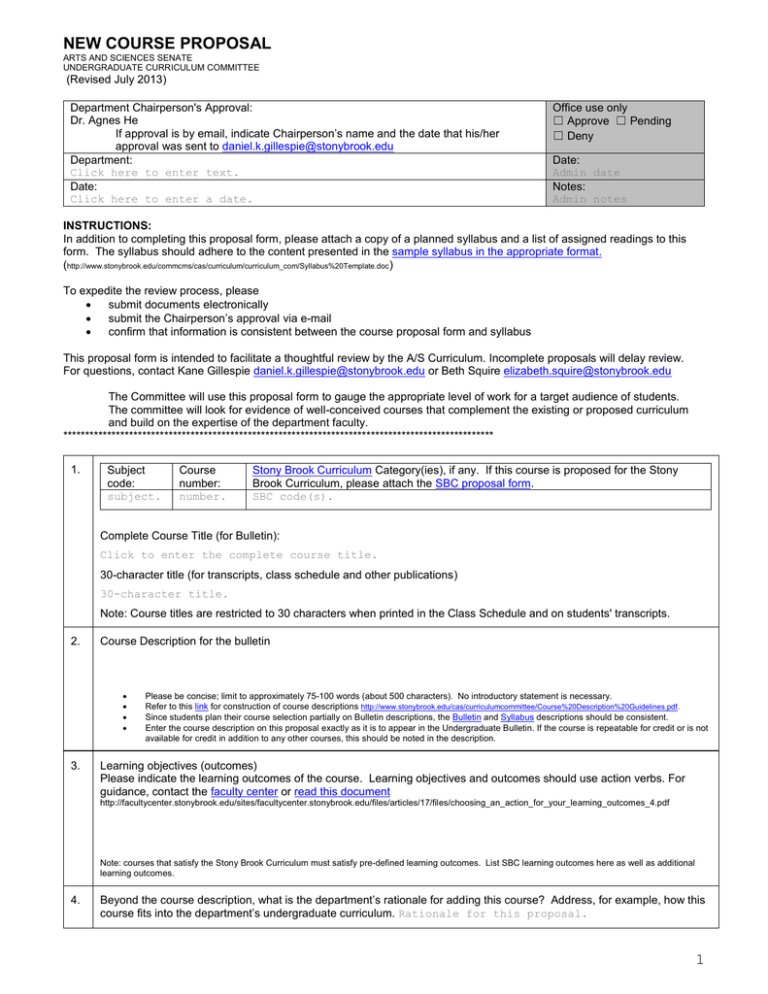
NEW COURSE PROPOSAL ARTS AND SCIENCES SENATE UNDERGRADUATE CURRICULUM COMMITTEE (Revised July 2013) Department Chairperson's Approval: Dr. Agnes He If approval is by email, indicate Chairperson’s name and the date that his/her approval was sent to daniel.k.gillespie@stonybrook.edu Department: Click here to enter text. Date: Click here to enter a date. Office use only ☐ Approve ☐ Pending ☐ Deny Date: Admin date Notes: Admin notes INSTRUCTIONS: In addition to completing this proposal form, please attach a copy of a planned syllabus and a list of assigned readings to this form. The syllabus should adhere to the content presented in the sample syllabus in the appropriate format. (http://www.stonybrook.edu/commcms/cas/curriculum/curriculum_com/Syllabus%20Template.doc ) To expedite the review process, please submit documents electronically submit the Chairperson’s approval via e-mail confirm that information is consistent between the course proposal form and syllabus This proposal form is intended to facilitate a thoughtful review by the A/S Curriculum. Incomplete proposals will delay review. For questions, contact Kane Gillespie daniel.k.gillespie@stonybrook.edu or Beth Squire elizabeth.squire@stonybrook.edu The Committee will use this proposal form to gauge the appropriate level of work for a target audience of students. The committee will look for evidence of well-conceived courses that complement the existing or proposed curriculum and build on the expertise of the department faculty. ************************************************************************************************** 1. Subject code: subject. Course number: number. Stony Brook Curriculum Category(ies), if any. If this course is proposed for the Stony Brook Curriculum, please attach the SBC proposal form. SBC code(s). Complete Course Title (for Bulletin): Click to enter the complete course title. 30-character title (for transcripts, class schedule and other publications) 30-character title. Note: Course titles are restricted to 30 characters when printed in the Class Schedule and on students' transcripts. 2. Course Description for the bulletin 3. Please be concise; limit to approximately 75-100 words (about 500 characters). No introductory statement is necessary. Refer to this link for construction of course descriptions http://www.stonybrook.edu/cas/curriculumcommittee/Course%20Description%20Guidelines.pdf. Since students plan their course selection partially on Bulletin descriptions, the Bulletin and Syllabus descriptions should be consistent. Enter the course description on this proposal exactly as it is to appear in the Undergraduate Bulletin. If the course is repeatable for credit or is not available for credit in addition to any other courses, this should be noted in the description. Learning objectives (outcomes) Please indicate the learning outcomes of the course. Learning objectives and outcomes should use action verbs. For guidance, contact the faculty center or read this document http://facultycenter.stonybrook.edu/sites/facultycenter.stonybrook.edu/files/articles/17/files/choosing_an_action_for_your_learning_outcomes_4.pdf Note: courses that satisfy the Stony Brook Curriculum must satisfy pre-defined learning outcomes. List SBC learning outcomes here as well as additional learning outcomes. 4. Beyond the course description, what is the department’s rationale for adding this course? Address, for example, how this course fits into the department’s undergraduate curriculum. Rationale for this proposal. 1 5. Is the course repeatable? For more information, see link (http://sb.cc.stonybrook.edu/bulletin/current/policiesandregulations/records_registration/multiple_registrations.php). Yes ☐ No ☐ if YES, please indicate the limit of repetitions and cumulative credits. If no limits, enter “none.” Limit of repeats. limit of repeats Maximum earned credits. maximum earned credits 6. Pre- or Co-requisites. See links http://www.stonybrook.edu/commcms/cas/curriculum/curriculum_com/Guidelines%20for%20Course%20Prerequisites%20rev.pdf http://sb.cc.stonybrook.edu/bulletin/current/policiesandregulations/records_registration/coursepqandplacement.php PRE-requisites, if any. If none, write “none.” Prerequisites. CO-requisite(s), if any. If none, write “none.” Co-requisites. Advisory Prerequisite(s), if any. If none, write “none.” Advisory prerequisites. 7. Grading Type (check one): ☐ A-F (Note: most undergraduate courses with A-F grading allow students to elect the GPNC option, unless specifically proposed and approved otherwise) ☐ A-C/U (a, b, c or unsatisfactory) (this grading type is rare) ☐ S/U 8. Course credits: credits (if students can select variable credit, indicate min and max) 9. How will the course be scheduled? Please give a brief but specific description of the a sample weekly meetings (eg, two hours of lecture and two hours of lab) Click here to enter text. On the chart below, please indicate the proposed sample meeting pattern for each means of instruction during Fall and Spring as well as the credits per instruction type. See link to class meeting times Proposed meeting pattern Credits per instruction type Notes Lecture Seminar Recitation Lab Studio Other Mtg pat Mtg pat Mtg pat Mtg pat Mtg pat Mtg pat credits credits credits credits credits credits weekly contact hrs must be adjusted when the course is offered in Summer or Winter sessions to accommodate those shortened semesters. If this course will only be offered during winter/summer, please specify here. Click. Course credits must correspond to contact time and/or time on task. Definitions for fall and spring semester instruction: Instr. Type Definition or example Contact time/ credit relationship Lecture Seminar Traditional instruction Round-table discussions Studio Usually for fine arts Recitation Lab (3 hr) Lab (2 hr) Film (3 hr) Film (2 hr) Online or mixed delivery Discussion/ working sections. Usually paired with a lecture Students work on prescribed assignments with guidance from faculty and TAs; usually paired with a lecture Students view films with guidance from faculty and TAs; usually paired with a lecture Online or mixed delivery For each hour in class, the state “expects” the average students to spend the indicated time outside of class studying and/or preparing 1 lecture hour (53 minutes) per week = 1 credit 2 hours (120 minutes) 1 seminar hour (53 minutes) per week = 1 credit 2 hours (120 minutes) 1 two-hour studio period (110 minutes) per week 1 hour (60 minutes) = 1 credit 1 recitation hour (53 minutes) per week = 1 credit 2 hours (120 minutes) 1 three-hour lab (2’50”) per week = 1 credit Little or none 1 two-hour lab (1’50”) per week = 1 credit if significant outside preparation is required 1 hour (60 minutes) 1 three-hour film showing (2’50”) per week = 1 credit Little or none 1 two-hour film showing (1’50”) per week = 1 credit if significant outside preparation is required 1 hour (60 minutes) Contact Kane Gillespie for more information ~40 hours total time on task per semester 2 10. Initial term offered: Initial term offered. Initial instructor: Initial instructor. If designated instructor becomes unavailable, are there others who can teach the course? Yes ☐ No ☐ If YES, who? Alternate instructor(s). 11. When will the course usually be offered? (Check as appropriate.) ☐ Fall ☐ Spring ☐ Summer I ☐ Summer II ☐ Winter 12. Frequency of offering, e.g. every semester, annually, alternate years, etc.: Frequency of offering. 13. Estimated enrollment: Est. enrollment. 14. Film and Video Use: Will films, videos, or clips be regularly used in the course? Yes ☐ No ☐ If yes, indicate how much time in the course will be used for screening and explain how the films, videos, or clips will be integrated into the course. Enter video/film time. Note: Stony Brook classifies a Film showing as a “lab.” SUNY guidelines stipulate that two hours of lab equal one contact hour only if significant outside preparation is required. Film labs typically require significant outside preparation, resulting in a 2 hour film lab. Otherwise, three hours of film/video viewing equal one contact hour. See links: http://www.stonybrook.edu/commcms/cas/curriculum/curriculum_com/Film%20and%20Video%20policy.pdf and http://www.stonybrook.edu/commcms/cas/curriculum/curriculum_com/Guidelines%20for%20Film%20and%20Video%20Scheduling.pdf 15. Computer Use: Will students be required to use computers for conducting experiments or projects other than word processing and internet access? Yes ☐ No ☐ If yes, indicate the nature of the work and facilities required (use of a SINC site or special computer laboratory, use of a PC at home or on campus). Indicate the approximate amount of time students will be required to engage in work on the computer outside of class. Significant computer work required outside of class time should be noted in the course description. Computer requirements 16. Are there adequate facilities (classroom, laboratory, and computer) currently available to support the course? Yes ☐ No ☐ If no, indicate specific deficits. Facility requirements. 17. (For Informational Purposes Only)--If availability of library resources (books, journals, newspapers, reference tools, manuscript and special collections material, and computer database access) is insufficient to support the proposed course, list new library resources needed. Library resources. 3 18. How will student performance be evaluated? Please indicate (a) number, type, and length of papers, examinations, lab reports, etc. Evaluative elements. (b) how the final grade will be calculated, expressed as in percentages of the evaluative elements? Please check that the percentages add to 100% Grade breakdown. 19. TA Use: (a) Will graduate teaching assistants be used in the course? Yes ☐ No ☐ (b) Will undergraduate teaching assistants be used in the course? Yes ☐ No ☐ (c) If the answer to either a or b above is yes, please explain how each will be used: TA usage. 20. Course Level: a. For what level and type of students is this course primarily intended, i.e., freshmen, sophomores, upperdivision students, majors, non-majors, or pre-professional students? b. If the course is primarily for upper-division students, explain why it is an upper-division course, e.g., its format, difficulty of assignments, and required level of preparation. For more information, please see Link to guidelines for information about course levels 21. How does the course relate to the department’s undergraduate and/or graduate programs? Does it replace any existing course? Yes ☐ No ☐ If so, should the other course be inactivated? Yes ☐ No ☐ If yes, please specify: Click here to enter text. How does it complement other courses in the department's curriculum or integrate material from them? 22. Does the course necessitate a change in the department's major or minor requirements? Yes ☐ No ☒ If YES, please give specific details here. Attach additional documents if needed. Click here to enter text. 23. Please consider the new course's relation to undergraduate (or graduate offerings) in other programs throughout the University. Consider, for example, whether the course duplicates or overlaps with existing courses. Would the course appropriately be crosslisted with another department? Might it serve as a prerequisite for courses in other departments? Might it compete for resources now used for other purposes? Does the course affect major or minor requirements in any other department? If so, please specify. Note: If other departments are affected (e.g., the course will change a prerequisite or a major requirement or considers material typically considered the domain of another department), the committee requires that the department consult with the affected departments about the proposed course and its ramifications and that the affected departments agree to the offering of the course. Courses will not be crosslisted without consent from all participating departments. 24. Curriculum C integration How does this new course correspond to other offerings at Stony Brook? How will this course impact the delivery of other curricula at Stony Brook? Is it similar to or overlap with other offerings? If so, please provide written evidence via email of a review by each relevant department as well as a brief response here. 4 25. Indicate a weekly plan of class topics and assignments. Week 1. 2. 3. 4. 5. 6. 7. 8. 9. 10. 11. 12. 13. 14. 15. 26. Topic of discussion See the syllabus Click here to enter text. Click here to enter text. Click here to enter text. Click here to enter text. Click here to enter text. Click here to enter text. Click here to enter text. Click here to enter text. Click here to enter text. Click here to enter text. Click here to enter text. Click here to enter text. Click here to enter text. (week 15 is finals week for fall/spring) Please indicate a list of assigned readings. Include a bibliography if possible. 5
